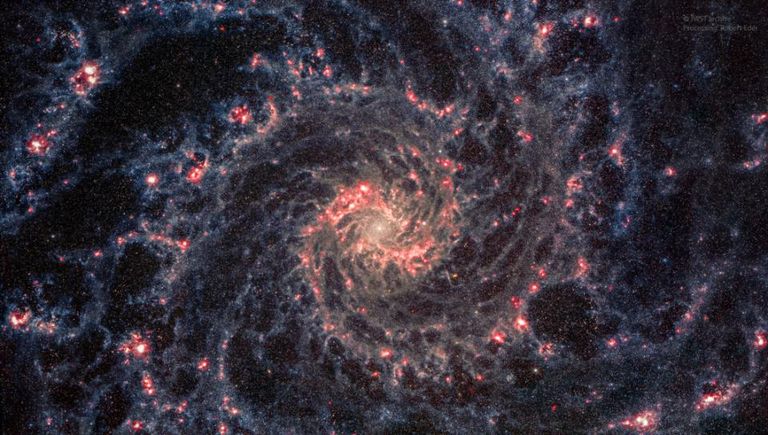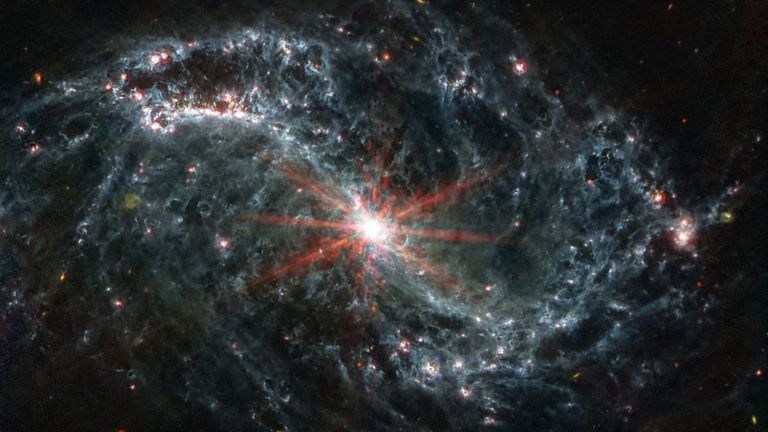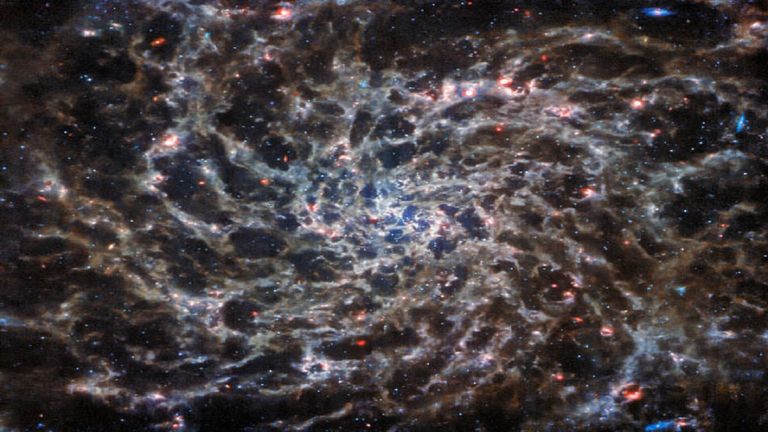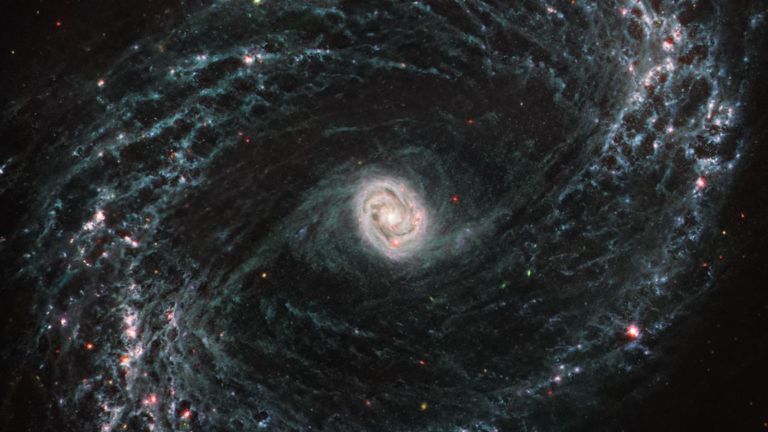This brand-new image of Pandora's cluster, a gigantic cluster of galaxies, was produced by the James Webb Space Telescope and has 50,000 near-infrared light sources. Astronomers may observe galaxies farther behind it thanks to the cluster's effect of amplifying light.
The James Webb Space Telescope has allowed astronomers to look into the center of spiral galaxies, where nascent stars are tracing the courses of light.
Five of them, including galaxies M74, NGC 7496, IC 5332, NGC 1365, and NGC 1433, have so far been closely observed by the telescope.

source
In the direction of the constellation Pisces, around 32 million light years away, is the stunning spiral galaxy Messier 74. Astronomers have long praised M74, an island universe of over 100 billion stars with two distinct spiral arms, as the ideal illustration of a large-design spiral galaxy.
The core portion of M74 is brought into breathtaking, precise focus in this freshly processed image utilizing data from the James Webb Space Telescope that is available to the general public.
Telescopes are uniquely positioned to see through the dust that some galactic features are obscured by when less powerful telescopes are utilized because space observatories can observe the universe in infrared light, which is undetectable to the human eye.

source
Young stars are creating shells and bubbles that are all across the spiral arms of galaxy NGC 7496.
Galaxies appear dark and dull in visible light. But, Webb's Mid-Infrared Instrument can observe how the structure of galaxies can be formed by stars and star clusters. The Webb photos' previously unseen level of detail demonstrates how the complex networks within these galaxies are impacted over time as stars develop and change.

source
About 25 million light years away, in the constellation of Sculptor, is where you can find IC5332. This galaxy, often referred to as ESO 408-9 or LEDA 71775, was found on November 19, 1897, by American astronomer Lewis Swift.
The IC 5332 has visible spiral arms and a very modest center projection.
We can observe the symmetrical sweep of its spiral arms because of its remarkable alignment with Earth, which is practically flawless.
Its diameter, which is only approximately a third that of our Milky Way Galaxy, is 66,000 light years.
Webb's infrared capabilities were utilized to examine 19 spiral galaxies by PHANGS (High-Angle-resolution Physics of Nearby Galaxies) collaborators.

source
This view of NGC 1365 taken with the Webb telescope reveals a network of bubbles and cavernous shells formed as young stars release energy into the spiral arms of the galaxy.
It was incredible to witness firsthand how young star formation activity influences the gas surrounding them, said Erik Rosolowsky, a PHANGS team member and professor of physics at the University of Alberta in Canada.
The spiral arms of galaxies are surrounded by enormous bubbles of gas and dust that are produced as stars release energy. Occasionally, these bubble-like characteristics overlap to form shells and structures resembling spider webs.

source
This photograph of NGC 1433, a barred spiral galaxy with a bright center and a twin star-forming ring, was taken by the James Webb Space Telescope.
Adam Leroy, a member of the PHANGS team and professor of astronomy at Ohio State University, said, "The PHANGS team has spent years observing these galaxies at optical, radio, and ultraviolet wavelengths using NASA's Hubble Space Telescope, the Atacama Large Millimeter/submillimeter Array, and the Very Large Telescope Multi-Unit Spectroscope."
The very beginning of a star's life cycle, however, is obscured by gas and dust clouds, making it difficult to observe.
The observation program will continue to concentrate on several galaxies, conduct star formation censuses, and uncover new information about the star life cycle and how stars affect the galaxies they inhabit.
Congratulations, your post has been curated by @r2cornell, a curating account for @R2cornell's Discord Community.